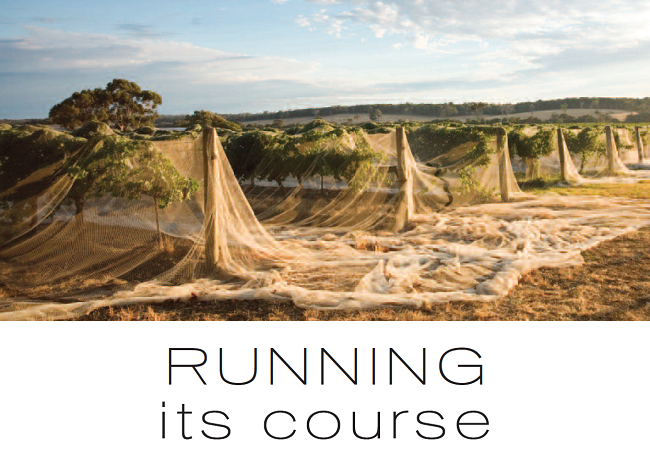RUNNING its course – The Drinks Business – January 2015

RUNNING its course – The Drinks Business – January 2015
Superb article about Margaret River wine region and Moss Wood in The Drinks Business magazine, January 2015 edition. Here is an extract.
Click on this link to read the entire article: Read the article
“It may only be a few decades since Australia’s Margaret River was first planted, butas Stephen Brook writes, an artisanal passion for fine wine is already deeply rooted.
[…]
AGEING GRACEFULLY
If one of the criteria for establishing the seriousness of a wine is its capacity to age, then Margaret River reds as well as whites have no difficulty at all passing that test. Cullen Cabernets from the late 1970s and Moss Wood Cabernets from the early 1980s are still impressive decades later. Since these wines were made from vines no more than ten years old, their survival is remarkable. Perhaps they would have been even better five or ten years ago, but nonetheless the wines, though mature, have not faded. There is little doubt that the Cabernets being produced today at the top estates will age even better than those wines from the 1970s and 1980s.
Those founding wineries – Vasse Felix, Moss Wood, Cullen, Cape Mentelle, and Leeuwin – are still among the great names of the region. Indeed, many of the Margaret River pioneers – such as Denis Horgan of Leeuwin and Keith Mugford of Moss Wood – are still active, though in some cases handing over management of their wineries to the next generation.
[…]
The speed with which Margaret Riverdeveloped its vineyards and reputation is striking. It avoided the phase – which, for example, New Zealand went through – of planting mediocre varieties before, after much trial and error, it realised its strength lay in Sauvignon, Chardonnay, and Pinot Noir. From the outset the Margaret River pioneers planted the varieties for which it is still best known today. Good though the early vintages were, there is no doubt that the farming and winemaking today are more expert and consistent.
Keith Mugford of Moss Wood says: “I am not someone who looks back at the good old days. Quite the opposite. I know we make better wines in 2013 than we did when I arrived here in 1979 and that’s the way it should be. How would it reflect on us if we spent more than 30 years doing something without learning ways to improve it?” One clear difference is that the fruit is picked at higher ripeness levels. That does inevitably result in higher alcohol, but few wines seem over-alcoholic and thus unbalanced. The Margaret River climate doesn’t easily permit excesses, which is why the wines are so consistent.
QUALITY ON OFFER
The emphasis has always been on quality because the region is not well suited to mass production. There are other regions of Australia where a high degree of mechanisation permits high-volume wines of decent, if not exceptional, quality to be produced. There is some mechanisation in Margaret River, especially during harvest, but most vineyards are small and tend to be cultivated by hand. These labour costs account for the high prices of many of the wines, as well as the fact that Western Australia is an isolated area, so every item that’s needed – bottles, corks, filters – has to be shipped in and then the final wines need to be shipped out. It’s not difficult to do, but it is expensive.
If there is a bargain style in Margaret River it is probably the blend of australia: margaret river Sauvignon Blanc and Semillon that has found itself a natural home here. Semillon was a variety planted long ago in the region, and is made both in oaked and unoaked styles. A few wineries, such as Moss Wood, still make a pure Semillon.
Almost every winery in Margaret River produces a Sauvignon/Semillon blend. It’s a style that has been associated with Margaret River for about three decades. The freshness and acidity of the Sauvignon blends beautifully with the fatter, richer Semillon fruit, and sometimes a proportion of the wine is fermented in oak to give more texture. These wines are rarely very expensive, but have the merit of charm and drinkability.
But the true strengths of Margaret River lie with Chardonnay and Cabernet Sauvignon. Each important producer tends to have its own style, although this can change as winemakers come and go. Cullen’s wines have great concentration and structure; the Moss Wood Cabernets are more richly textured than some other reds from the region; Vasse Felix Chardonnays have a pure and crystalline quality; Fraser Gallop produces rather austere wines that are beautifully balanced and will age well; and Leeuwin’s Cabernet and Chardonnay both show considerable power and weight. Less well-known producers such as Juniper, Xanadu, and Howard Park are now regularly making wines of exceptional quality, both white and red.
The hallmark of Margaret River is consistency. The climate plays a large part in this, of course, but so does the human scale of the vineyards, which give the region an almost European atmosphere.
It’s the proliferation of family-owned properties, the passion for good food, and the exaltation of fine wine as a cultural, not just a commercial, asset. The region is extremely young, yet has already planted deep roots.”
